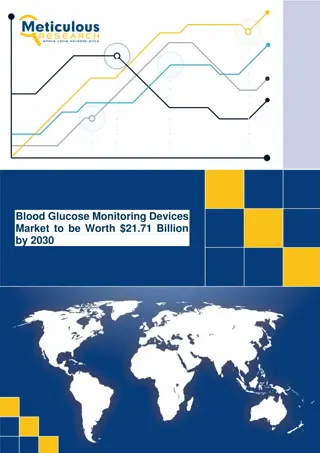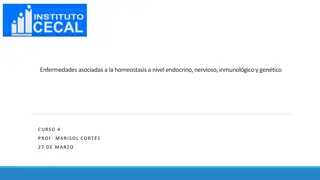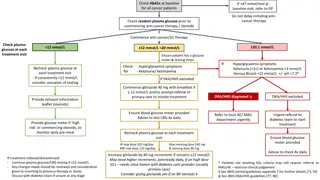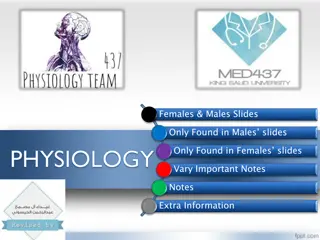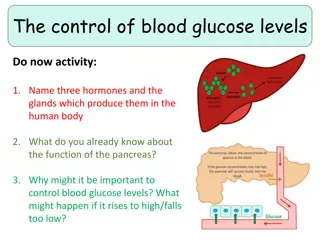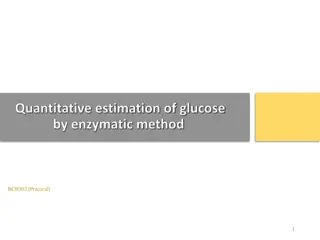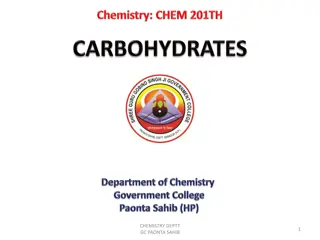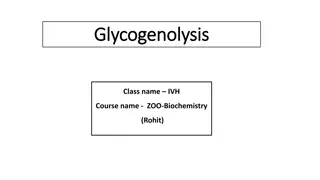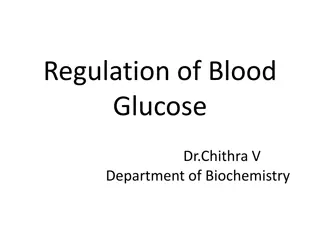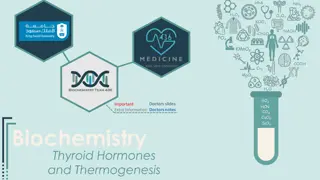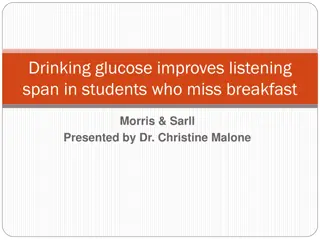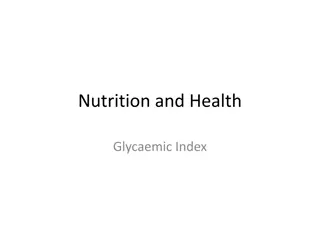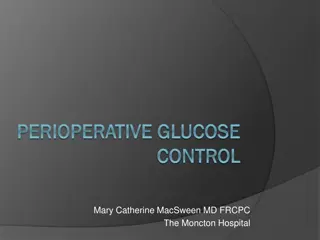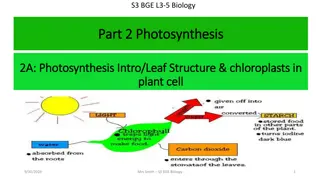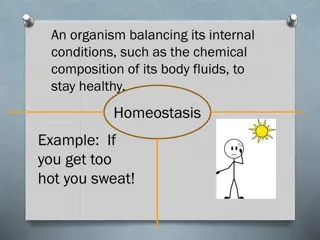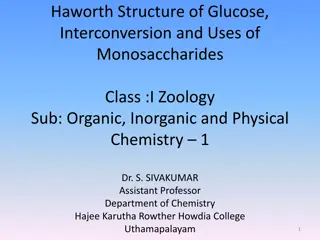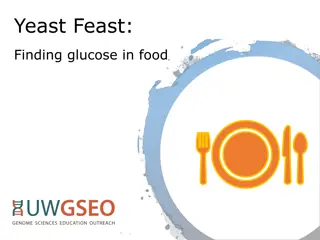Comprehensive Biochemical Tests Training Guide
Enhance your skills in conducting fasting blood glucose, post-prandial glucose, and oral glucose tolerance tests with this comprehensive training guide by Mohammed Al-Zubaidi, PhD. Master the techniques and interpretations for accurate results.
1 views • 42 slides
Understanding Gestational Diabetes: Risk Factors, Diagnosis, and Management
Gestational diabetes is a condition where high blood sugar levels develop during pregnancy in women without pre-existing diabetes. Risk factors include maternal age, family history of diabetes, ethnicity, and obesity. Diagnostic tests involve measuring blood glucose levels, and management includes a
1 views • 15 slides
Understanding Insulin Pump Therapy and Continuous Glucose Monitoring
Exploring the basics of insulin pump therapy, including the basal/bolus concept, operation of insulin pumps, advantages and limitations, day-to-day living with a pump, continuous glucose monitoring, and available systems.
1 views • 45 slides
Blood Glucose Monitoring Devices Market to be Worth $21.71 Billion by 2030
Blood Glucose Monitoring Devices Market by Product (Self-monitoring {Glucometer, Test Strips, Lancets}, Continuous Glucose Monitoring {Sensors, Receiver, Transmitter}), Diabetes Type, End User (Self\/Home Care, Hospital, Clinic) - Global Forecast to 2030.
1 views • 3 slides
Understanding Diseases Associated with Homeostasis in Endocrine, Nervous, Immunological, and Genetic Levels
Exploring diseases related to disruptions in homeostasis at endocrine, nervous, immunological, and genetic levels, focusing on conditions like hormone imbalances and metabolic disorders such as growth hormone deficiency and diabetes. Learn about the impact on health and the body's intricate regulato
5 views • 38 slides
Understanding the Seliwanoff Color Reaction and its Significance
The Seliwanoff color reaction, discovered by Russian chemist Feodor Feodorovich Selivanov, is used to differentiate between aldoses and ketohexoses based on their dehydration and reaction with resorcinol in acidic conditions. Ketoses like fructose react faster than aldoses like glucose, leading to a
3 views • 20 slides
Overview of Glucose Metabolic Pathways in Clinical Chemistry
Explore the major metabolic pathways of glucose, including glycogenolysis, gluconeogenesis, glycolysis, and more. Understand the production, utilization, catabolic, and anabolic cycles of glucose in cellular metabolism. Learn about key concepts such as hexose interconversion, HMP/PPP, Krebs cycle, a
4 views • 29 slides
Case Study: Managing High HbA1c and Normal Fasting Glucose Levels
A case study discusses a 69-year-old woman with a history of stable diabetes facing elevated HbA1c levels despite normal fasting glucose. Initial investigations, including a day curve test, reveal high postprandial glucose levels. The analysis leads to identifying iron deficiency anemia, prompting f
9 views • 22 slides
Regulation of Energy Homeostasis by AMPK System and Its Modulation Factors
The AMPK system plays a crucial role in regulating energy homeostasis by sensing the cellular AMP:ATP ratio and responding to metabolic stresses that affect ATP production or consumption. AMPK is activated by factors such as hypoxia, glucose deprivation, and metabolic inhibitors, as well as by compo
0 views • 27 slides
Understanding Homeostasis in Living Organisms
Homeostasis, derived from Greek meaning "standing still", is crucial for maintaining balance in living organisms. It involves regulating internal variables to prevent disease or death. Ancient Greeks emphasized the importance of harmony and equilibrium in life. Claude Bernard and Walter B. Cannon fu
1 views • 29 slides
Understanding Calcium Metabolism: A Comprehensive Overview
Calcium metabolism plays a critical role in various bodily functions like nerve conduction, coagulation, and bone mineralization. It involves processes such as calcium absorption, distribution, and homeostasis, regulated by hormones like PTH and calcitriol. The balance of calcium in the body is cruc
7 views • 50 slides
Understanding Glycolysis: The Initial Step in Glucose Breakdown
Glycolysis, presented by Dr. Madhu Kumari Gupta, is a crucial process in cellular metabolism that involves the breakdown of glucose to extract energy. This pathway occurs in the cytosol and consists of three main phases - an energy-requiring phase, a splitting phase, and an energy-releasing phase. T
0 views • 12 slides
Understanding Cellular Respiration and Oxygen Delivery
Cellular respiration, a vital process for organ survival, involves mitochondria performing cellular respiration by utilizing glucose and oxygen. Glucose is derived from diet or body breakdown, while oxygen enters through the respiratory system, facilitated by red blood cells in the circulatory syste
0 views • 8 slides
Guidelines for Monitoring Blood Glucose in Cancer Patients Undergoing Anti-Cancer Therapy
Guidelines recommend checking HbA1c and random plasma glucose levels at baseline for all cancer patients before initiating anti-cancer therapy. Regular monitoring of plasma glucose levels during treatment is essential, with specific actions based on glucose readings. Immediate referrals and treatmen
0 views • 4 slides
Understanding Homeostasis: Maintaining Internal Balance in the Body
The concept of homeostasis is crucial for understanding how the body maintains a stable internal environment despite external fluctuations. This presentation covers the definitions of positive and negative feedback mechanisms, components of feedback loops, and the role of homeostatic mechanisms in p
0 views • 33 slides
Understanding Blood Glucose Control Mechanisms in the Human Body
This content explores the regulation of blood glucose levels in the human body, covering the role of hormones like insulin and glucagon produced by the pancreas. It discusses the importance of maintaining proper blood glucose levels and the consequences of levels being too high or too low. The text
0 views • 19 slides
Managing Blood Sugar Levels at Home for Low/No Vision
Explore the importance of monitoring blood glucose levels at home for individuals with low/no vision, learn about talking blood glucose meters, and make continuous glucose monitors accessible. Understand why maintaining blood sugar levels is crucial to prevent complications in diabetes, and get tips
2 views • 25 slides
Understanding Homeostasis in Humans: The Key to Maintaining Internal Balance
Homeostasis refers to the body's ability to regulate and maintain a constant internal environment despite external changes. In humans, the tissue fluid plays a crucial role in this process, with factors like pH, water concentration, oxygen levels, temperature, and glucose content needing to be contr
0 views • 80 slides
Quantitative Estimation of Glucose by Enzymatic Method in Blood Samples
Estimation of blood glucose levels is crucial for diagnosing and managing conditions like diabetes mellitus. This practical involves using the enzymatic method with glucose oxidase to quantitatively determine glucose levels in serum. The enzymatic reaction converts glucose to gluconic acid and hydro
0 views • 8 slides
Epimerisation of D-Glucose into D-Mannose: Structural Insights
Explore the fascinating process of epimerisation, specifically the conversion of D-glucose into D-mannose. Discover the limitations of open chain structures, the ring structure of glucose, and the evidence supporting it. Learn about the stereochemistry of D-glucose, optical rotation, and the equilib
0 views • 13 slides
Understanding Homeostasis in Humans and Mammals
Humans and mammals rely on homeostasis to maintain a constant internal environment for survival. This involves regulating core body temperature, blood glucose levels, and water levels through nervous and hormonal responses. By understanding the principles of homeostasis, we can appreciate the vital
0 views • 22 slides
Understanding Metabolic Control Mechanisms in Cellular Regulation
Metabolic control mechanisms play a crucial role in maintaining homeostasis within cells by regulating metabolic pathways. This involves finely adjusting the output of pathways in response to external signals, ensuring the proper flux of metabolites to meet cellular needs. Pacemaker enzymes, such as
1 views • 17 slides
The Importance of Glycogen in Providing a Constant Source of Blood Glucose
Glycogen serves as a crucial storage form of glucose in the body, ensuring a constant source of blood glucose crucial for brain function, RBC energy, and muscle fuel. This storage form is essential for providing glucose during times of fasting or increased energy demands, with glycogen synthesis and
0 views • 28 slides
Understanding Glycogenolysis in Vertebrates: A Detailed Overview
In vertebrates, glycogen serves as a glucose reservoir in the liver and skeletal muscles. Glycogenolysis is the breakdown of glycogen into glucose-6-phosphate, crucial for providing glucose to tissues in the absence of dietary sources. Enzymes like glycogen phosphorylase, debranching enzyme, and pho
0 views • 13 slides
Understanding Cell Membrane: Maintaining Homeostasis in Cells
Cells maintain homeostasis to function effectively. The cell membrane plays a crucial role in this process by regulating material exchange, separating the cell from its environment, and ensuring internal balance. Understanding how cells exchange materials through the membrane is key to comprehending
1 views • 16 slides
Regulation of Blood Glucose and Its Importance in Maintaining Health
Blood glucose regulation is crucial for energy supply in the body, particularly for brain function. Understanding the balance of glucose entering and leaving the blood through processes like absorption, glycogenolysis, and gluconeogenesis is vital. Hormones like insulin and glucagon play key roles i
0 views • 10 slides
Understanding Glucose Homeostasis in Metabolic Processes
Glucose homeostasis is crucial for controlling glucose metabolism and maintaining normal blood glucose levels in the body. It involves various metabolic sources, including dietary intake and gluconeogenesis. The liver plays a vital role in regulating blood glucose levels, while severe hypo- and hype
0 views • 17 slides
Analyzing the Impact of Glucose on Students' Listening Span
Research presented by Dr. Christine Malone explores how drinking glucose can enhance listening span in students who miss breakfast. The study investigates if the experiment qualifies as a true experiment by analyzing key features like manipulation, measurement, comparison, and control. Internal vali
1 views • 12 slides
Understanding Homeostasis in Organisms
Homeostasis is the key to maintaining internal stability in living organisms, ensuring they return to a stable state after fluctuations. This involves various body parts such as the kidneys, skin, liver, and pancreas. Different systems like body temperature regulation, blood pressure control, and os
1 views • 51 slides
Disposable Glucose Nanosensor Development Project
This project aims to develop a disposable glucose nanosensor and testing method to detect a range of concentrations. The goal is to create a low-cost and easy-to-fabricate nanosensor by designing an effective fabrication process. Steps involve cleaning the microscope slide, depositing titanium and a
0 views • 14 slides
Understanding Cell Transport and Homeostasis in Biology
Delve into the world of cell transport and homeostasis, exploring the functions of the cell membrane, the molecules involved, the fluid mosaic model, and passive transport mechanisms like diffusion, osmosis, and facilitated diffusion. Learn about the intricacies of maintaining equilibrium within cel
0 views • 10 slides
Understanding the Importance of the Immune System for Homeostasis
Explore the intricate workings of the immune system, from its component parts and defense mechanisms to the significance of homeostasis maintenance. Discover how non-specific and specific immune responses, phagocytosis, neutrophils, natural killer cells, and interferons play vital roles in protectin
0 views • 32 slides
Understanding Glycaemic Index in Nutrition and Health
Glycaemic Index (GI) measures how carbohydrate-containing foods affect blood glucose levels. High GI foods raise blood glucose rapidly, while low GI foods release glucose gradually. Studies track impacts on blood glucose levels, insulin secretion, fat storage, and pancreatic function. High GI foods
0 views • 15 slides
Understanding Body Systems and Homeostasis in Physiology
Explore the levels of organization in biology, physiological systems, scientific methods, and data analysis in this week's unit. Delve into the concept of homeostasis, how body systems interact to maintain balance, and the key functions of various organ systems. Understand the importance of homeosta
0 views • 55 slides
Perioperative Glucose Control in Diabetes Management
Managing perioperative glucose levels is crucial for patients with diabetes to prevent complications and improve outcomes. This case-based scenario discusses strategies for perioperative glucose control in different diabetic patients, emphasizing the importance of monitoring and individualized treat
0 views • 47 slides
Understanding the Role of Glucose in Photosynthesis
Exploring how plants use glucose produced during photosynthesis, including its various uses such as providing energy, being stored as starch, and contributing to the formation of plant cell walls and other essential chemicals. The process of photosynthesis, the fate of glucose, and the conversion of
0 views • 11 slides
Understanding Calcium Homeostasis and Its Importance in the Body
Calcium homeostasis plays a crucial role in various physiological functions, including bone integrity, blood clotting, enzymatic regulation, hormonal secretion, neurotransmitter release, nerve excitability, and muscle contraction. Bones act as a major calcium reservoir, with blood containing 50% ion
0 views • 17 slides
Understanding Biological Responses: Homeostasis, Stimuli, and Feedback Mechanisms
Explore the concepts of homeostasis, stimuli, and feedback mechanisms in biological systems. Learn how organisms maintain internal balance, respond to internal and external stimuli, and regulate bodily functions through feedback processes. Discover examples of responses such as sweating when hot, sq
0 views • 10 slides
Uses and Conversions of Glucose and Fructose in Chemistry
Glucose and fructose have various uses, including as food for patients and in confectionery. Glucose is also used in silvering mirrors, processing tobacco, and starting material for vitamin C synthesis. Fructose is a sweetening agent and a sugar substitute. Glucose can be converted into fructose thr
0 views • 10 slides
Understanding Glucose and Its Role in the Body
Delve into the significance of glucose as a primary energy source in our diets, the various sources of glucose in food, and the enzymes involved in breaking down sugars. Explore the connection between glucose and type 2 diabetes, emphasizing the importance of maintaining healthy blood glucose levels
0 views • 10 slides



